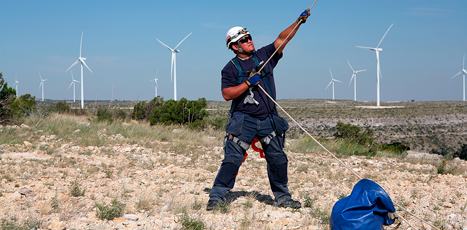The United States is now the top market worldwide for wind power, says an industry report.
U.S. had 45,100 wind turbines at the end of 2012, a growth of 28% over 2011.
Wind power in the U.S. is doing well, and the country has only just begun to tap its massive potential (especially offshore). According to the U.S. Wind Industry Annual Market Report for 2012 by the American Wind Energy Association, wind power had its best year ever in 2012, with a year-over-year growth in capacity of 28% coming from 6,700 new wind turbines, bringing the country’s total to about 45,100.
2012 also saw some interesting records: “Xcel Energy’s Colorado system has obtained more than 50 percent of its electricity from wind on multiple occasions. All these have been achieved reliably for electric customers, as utilities become increasingly familiar with integrating more wind power into their operations.”
More than 6,700 wind turbines were installed last year, the American Wind Energy Association’s report says, supplying enough electricity for 3.5 million homes. The nation finished 2012 with a total of 45,100 wind turbines that can power 15.2 million homes.
“We saw an uptick in every region of the country for new installations in 2012,” said Emily Williams, AWEA’s senior policy analyst. “Wind is making a big mainstream impact across the country.”
With more than 13 gigawatts of new capacity, wind represented the year’s leading builder of new US generation capacity with a 42 percent share, the report says.
The wind association said GE had retained its position as the U.S. market turbine manufacturing leader, with a 38.2 percent share.
Siemens captured a 20.1 percent share, moving from its third place ranking in 2011 to second. Vestas, which had been in second place, dropped a notch to third with a 13.8 percent share. Gamesa jumped ahead from ninth to fourth place
Yet many energy majors are struggling to make their renewable energy efforts as economically profitable as more traditional energy sectors.
BP said earlier this month it plans to sell its U.S. wind energy portfolio and concentrate on oil and natural gas developments. The company has 16 wind farms in nine states and other projects under development.
Wind farm developers had relied on a federal production tax credit, which had been in place for several years with no interruption, to help finance their projects.
In 2012 developers scrambled to bring projects online before the feared end of the PTC, due to expire at the end of 2012.
“The lack of 2013 certainty over federal tax credits precluded developers from placing orders for wind turbines during 2012 for future development,” AWEA’s report states.
For GE, the number of turbines ordered in the fourth quarter of 2012 was less than half the number in the equivalent period of 2011, The Financial Times reports.
The PTC was extended for one year by Congress on January 1 and includes new language that will allow the benefit to apply into 2014.
But Patrick Jenevein, chief executive officer of Tang Energy Group in Dallas, the nation’s largest producer of wind energy, writing in an oped piece in The Wall Street Journal earlier this month, questioned the merits of subsidies and tax credits.
“Government subsidies to new wind farms have only made the industry less focused on reducing costs,” Jenevein wrote. “In turn, the industry produces a product that isn’t as efficient or cheap as it might be if we focused less on working the political system and more on research and development.”
“Without subsidies, the wind industry would be forced to take a hard fresh look at its product,” he stated.


